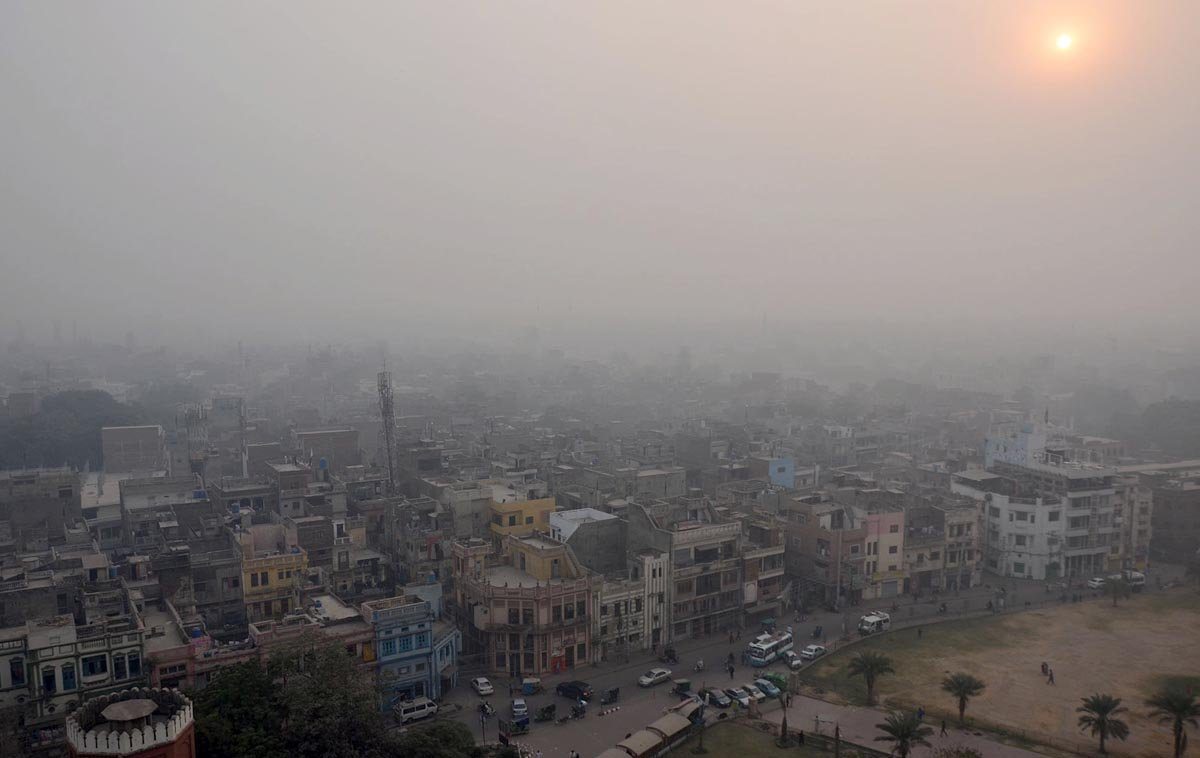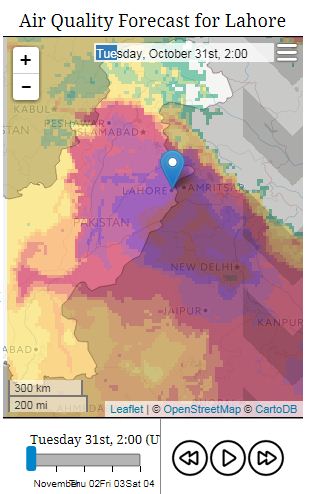Lahore’s smog returns


Once again its the time of the year, when Lahore it seems gets covered with a nasty and almost irritating smog. A haze of thick pollutant smog covers the sky blocking out the sun, obstructing the view when you drive or walk on the road and we hear reports of citizens complaining about the ailments from this sudden rise in the concentration of pollutants in the air.
But the question arises what is causing this foul smog to emerge at this time of the year and why isn’t anything being done to control it?


If we explore the problem of bad air quality in Lahore in detail, we will see that the scope of this issue is not so simple to comprehend nor too complex to resolve.
Lahore, Pakistan’s second largest city and home to more than 10 million people unusually experiences a sudden elevated rise in air pollutants which is a combination of urban air pollution, calm wind (mainly in the winter months) and penetration of polluted air from India causing visibly dense smog that is said to have worsened over the past five years.
Air pollution has emerged as a major health issue in the country causing almost 60,000 deaths because of the rising high levels of fine particulate matter in the air and Pakistan due to its air pollution is now listed as one of the deadliest places in the world according to a 2016 report by World Health Organisation (WHO).
An ever-increasing rise in industrial development in Punjab combine with unrestricted tree felling and vehicular emissions are all so commonly blamed for the being the real culprits behind the rise in air pollution in Lahore, but equally so a growing number of crop fires and coal plant emissions burning in neighbouring India are also contributing to the mix of pollutants worsening the air quality.
A recently published report by the Lancet Commission identified pollution (including air pollution) as the worst environmental culprit responsible for premature deaths and diseases in the world especially in rapidly industrialising countries like Pakistan, India, China and Bangladesh. The report claims that almost 22 percent of premature deaths in Pakistan are attributable to pollution — and this comes to about 300,000 deaths annually more than the deaths caused by road accidents in the country.
According to the latest WHO figures, there are some alarming facts that are concerning a lot of experts about the deteriorating air quality in Lahore.
Pakistan’s median exposure to pollutants like (CO) Carbon monoxide, Oxides of Nitrogen (NO2), Sulfur dioxide (SO2) and other fine particulate matter is around (PM 2.5), which is the most harmful concentration of pollutants in the air.
According to this source a yearly average of 68 µg/m3 of PM2.5, can be simply defined as Lahore being ranked at a figure of 155 (Unhealthy) on the Air Quality Index. However, air pollution can reach much higher and even hazardous levels with the worst that was experienced last year in November 2016.
Similarly, data obtained from noted climate expert Dr. Mehmood Khalid confirmed on Radio Pakistan that according to fresh readings from the recently installed monitoring equipment, the level of carbon monoxide was 21.29 (milligram per metre) on the Mall Road, 17.52 in Mohlanwal, and 6.94 in Gulberg’s Liberty Market as against the maximum permissible limit of 5.
Dr. Khalid Hussain from Services Hospital speaking to Radio Pakistan said, ‘that heavy smog was also a major reason these days for an increase in casualties in road accidents due to poor visibility.
He urged people to travel around in facemasks to be safe from breathing the heavy smog which can cause respiratory illnesses, throat infection and irritation of eyes and nose.
Rafay Alam, a Lahore based lawyer and environmentalist speaking to Daily Times said, “When the smog hit the city last year, the Lahore High Court directed the Environmental Protection Department (EPD) to acquire air quality monitors and to come up with a strategy to deal with smog. One year later, when the smog was again upon us, the EPD has had a smog policy approved. The meters have only just arrived and I believe are in the process of being installed. “
According to Mr. Alam, “It’s been a very sluggish effort put forward in face of this impending public health emergency, though the policy itself is ambitious yet it remains to be seen how the provincial EPD will lobby the Federal Government to improve fuel standards and emission standards for automobiles. Also, the policy is silent on generators used in urban areas even though these are mentioned as contributors to the pollution in the city.”
Last year in October 2016, the Government of the Punjab submitted a report to the Supreme Court of Pakistan detailing the steps that need to be implemented in order to reduce the rising air pollution in the province. According to the report, there has been a sudden increase in the number of vehicles in Lahore during the past few years, due to which the air quality has only worsened.
Because public transport infrastructure in Lahore was never so developed, it has proven to be a barrier in reducing the number of vehicles on the road. The Orange Line Metro project, major mass transit project which is anticipated to be operational in 2018 is said to be an ambitious move towards dramatically increasing public transport in the city but critics have warned against massive infrastructure development projects like Orange Line which has over the past two years contributed to the cutting and felling of around 2,200 trees according to the project’s EIA report.
Imrana Tiwana, an architect and heritage rights activist from the Lahore Conservation Society told Daily Times that, “Tree cover and green spaces help improve urban air quality by filtering it, it removes heat-trapping carbon dioxide from the atmosphere and increases the amount of the oxygen in it for improved public health.”
“Thus, removal of green areas contributes to a rapid rise in motor vehicles, soaring building construction activities, emission of heat from air conditioning units and encroachments on natural rainwater drains have converted urban centers into heat islands,” she added.
According to Ms. Tiwana, “Air pollution levels are increasing due to a rapid and unchecked increase in vehicles and uncontrolled infrastructure development, there should be a proper emission standard that needs to be implemented.”
Concerned about the rapid deterioration and destruction of Lahore’s cultural and natural heritage, Ms. Tiwana added, “There is an urgent need to address this crisis through an extensive public awareness campaign and the government should respond to the crisis too by establishing an independent authority to assess air quality and heritage damage associated with industrial effluents, emissions, and vehicular fumes. Uncontrolled pollution is destroying the Lahore Fort, Badshahi Mosque and other heritage monuments and sites in the 4000-year-old historic city of Lahore.”
The urban air pollution levels in Pakistan are at its worst and adversely damaging public health and quality of life of its citizen. the most vulnerable and marginalized in our society are by far the most affected like women, children, elderly and those who already suffer from chronic illnesses.
Controlling this rise in air pollution can not only lead to a resolution of a very severe public health emergency but also serve as an opportunity for economic development opportunity through our national shift towards renewable energy that can slow down the pace of climate change in Pakistan, which is often stated as a ‘threat greater than terrorism itself‘.
Leave a Comment